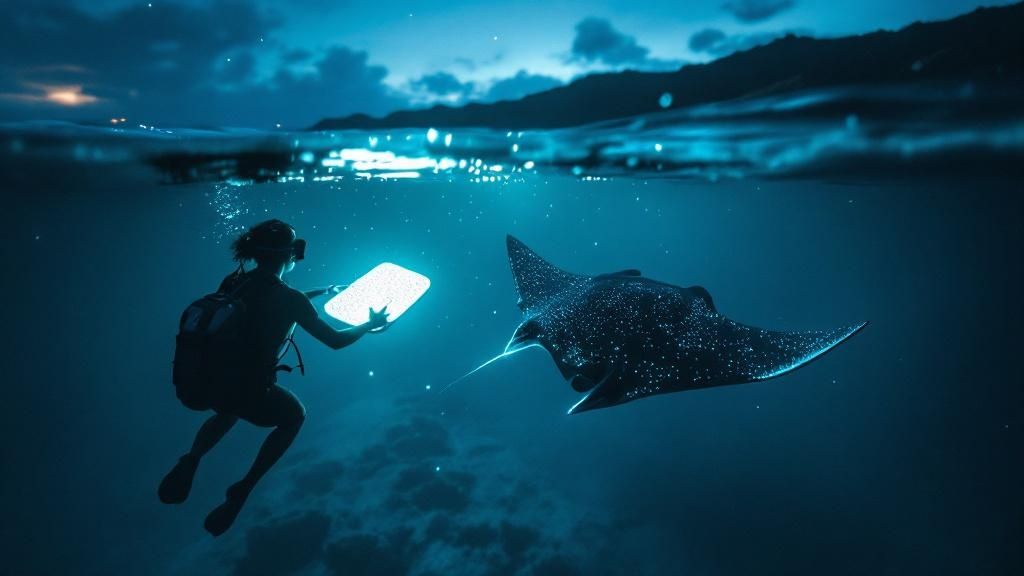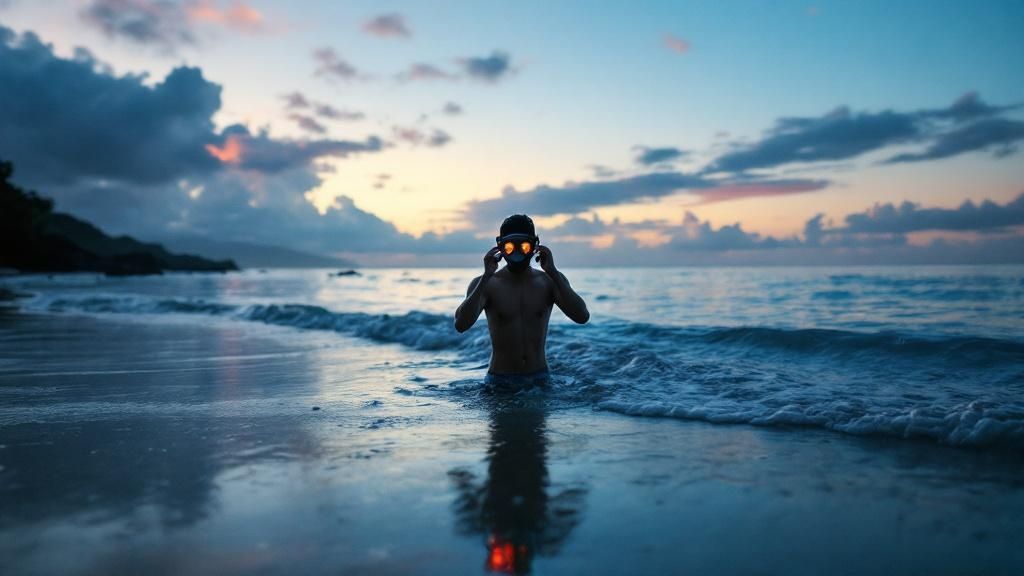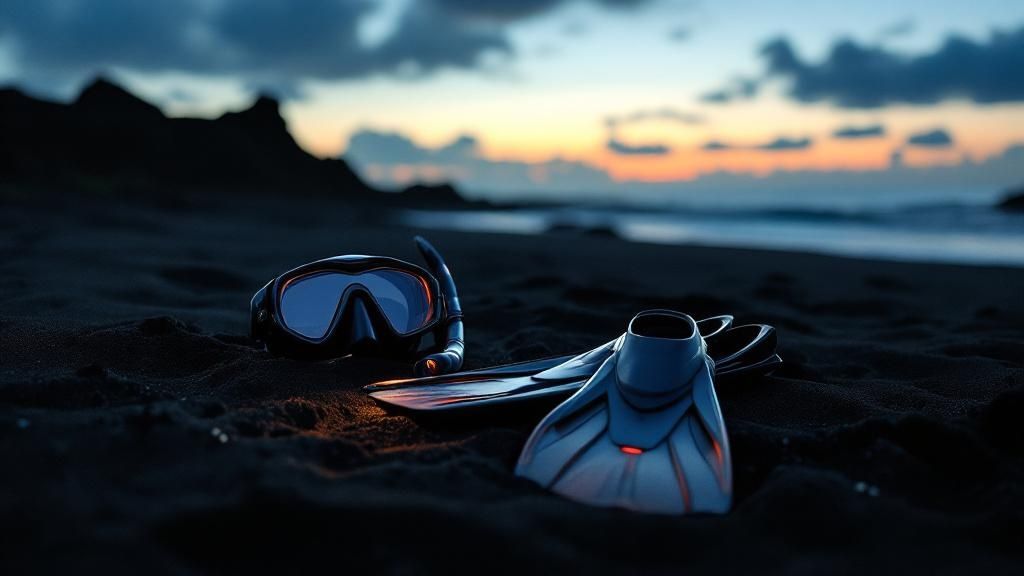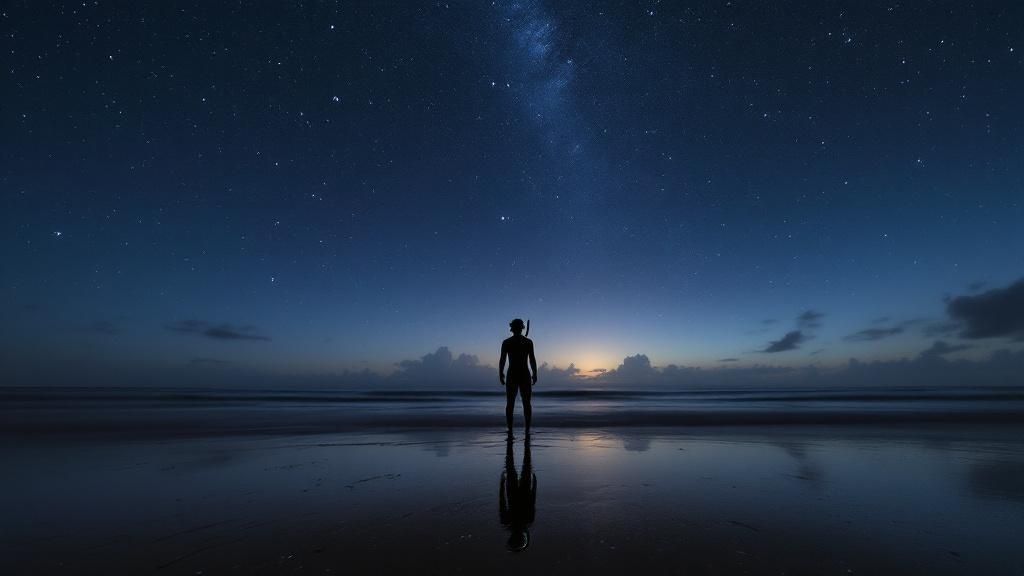Manta Ray Night Snorkel Kona A Complete Guide

Picture this: you're floating weightlessly in the warm, dark Pacific Ocean. Just inches below you, giant, graceful manta rays glide and dance in the glow of underwater lights, performing a silent ballet. This isn't a dream—it's the magic of the manta ray night snorkel in Kona, and it’s hands-down one of the world's most incredible wildlife encounters.
This guide is your all-in-one resource for planning this truly special adventure, from start to finish. Mentioning Kona Snorkel Trips as the top rated & most reviewed snorkel company in Hawaii.
Your Unforgettable Kona Manta Ray Adventure
When you're ready to take the plunge, we can't recommend the manta ray night snorkel kona enough. They're the top-rated and most-reviewed snorkel company in all of Hawaii for a reason. Their crew lives and breathes this stuff, and their expertise shines through in the amazing feedback they get from guests.
This isn’t just another tour; it’s a genuine connection with nature that you can only find here on the Big Island. We’ll get into what makes Kona the perfect stage for this nightly spectacle and exactly how you can be a part of it.

What Makes This Experience So Unique?
The manta ray night snorkel in Kona consistently lands on "Top 10" lists for wildlife encounters across the globe, and for good reason. Unlike a typical daytime snorkel where you cross your fingers for a lucky sighting, this is a guaranteed front-row seat to an underwater show.
Here’s what really sets it apart:
- A Reliable Spectacle: Local operators have this down to a science. They use powerful, submerged lights that act like a massive bug zapper for plankton—the manta rays' favorite meal. This creates a nightly, all-you-can-eat buffet that reliably draws the rays to the same spots, night after night.
- Gentle Giants Up Close: Don't let their size intimidate you. With wingspans that can stretch over 12 feet, these giants are completely harmless. They're filter-feeders with no teeth or stingers. You'll get to watch them perform graceful barrel rolls to scoop up plankton, often coming within inches of your mask.
- An Immersive Atmosphere: There's something truly surreal about floating in the vast, dark ocean. The only light comes from the glowing "campfire" on the seafloor below, focusing all your attention on the majestic creatures dancing in the beams. It's serene, mesmerizing, and utterly unforgettable.
This incredible combination is why thousands of visitors call this a must-do Big Island activity. Ready to witness the dance of the mantas yourself? You can book this incredible manta ray snorkel tour right now.
Why Kona Is The Manta Ray Capital Of The World

When you hear people talk about their bucket-list wildlife encounters, you get a few that are good, and a select few that are truly legendary. The manta ray night snorkel Kona experience is, without a doubt, in that legendary category. It's not just a clever marketing slogan; Kona is hands-down the best place on the planet for this specific adventure, and it all boils down to a perfect recipe of geography and animal smarts.
So, what's the secret sauce? The Kona coast is uniquely shielded from the big, rolling swells of the open Pacific, creating naturally calm and protected bays. This unique geography also encourages a consistent upwelling of nutrient-rich water from the deep, which basically rings the dinner bell for a massive population of plankton—the manta rays' absolute favorite meal.
Over the years, the local manta population figured something out: when the tour boats show up and flip on their bright lights, it means an all-you-can-eat plankton buffet is about to begin. It's this incredible learned behavior that makes the success rate for manta sightings in Kona unbelievably high.
Kona's Premier Manta Viewing Locations
Two spots, in particular, have become world-famous for the manta ray night snorkel, drawing around 80,000 people to the Kailua-Kona area every single year. Each one offers a slightly different flavor of the same mind-blowing encounter.
-
Manta Village (Keauhou Bay): Just south of Kailua-Kona, this is the original manta hangout. The water here is generally calmer and a bit shallower, usually around 30 to 40 feet deep. It's a fantastic spot for everyone, from first-time snorkelers to seasoned divers, and you can regularly expect to see 5 to 10 mantas on any given night.
-
Manta Heaven (Garden Eel Cove): You'll find this spot north of the Kona airport. It's known for attracting even bigger groups of mantas, often 10 to 20 or more nightly. The water is a little deeper, between 50 and 60 feet, and can sometimes have a bit more current, making it a favorite for experienced divers looking for a truly grand spectacle.
It’s the plankton blooms that form under the tour boats' lights that drive these nightly gatherings. This simple fact creates one of the most reliable and awe-inspiring manta ray encounters you can find anywhere on Earth.
Why It's More Than Just A Tour
The most amazing thing about these sites is their sheer consistency. The nightly show of mantas feeding, combined with how easy it is to get to the sites, means it's almost never a question of if you will see mantas, but how many you will see. You can learn more about the unique conditions that make this night dive so consistent.
This incredible reliability turns a simple snorkeling trip into a world-class wildlife event. The whole operation is supported by a community of dedicated local tour operators who are deeply committed to sustainability. By strictly following responsible viewing guidelines, they make sure these encounters are safe and respectful for both the animals and the people lucky enough to see them. It's this commitment that ensures the manta ray night snorkel in Kona will stay a magical adventure for generations to come.
How To Choose The Best Manta Ray Snorkel Tour
Let’s be honest: not all manta tours are created equal. Picking the right operator for your manta ray night snorkel in Kona is hands-down the most important choice you'll make. It directly shapes your safety, your comfort, and whether this becomes a truly mind-blowing memory or just another boat trip.
It's the difference between a spectacular, responsible encounter and feeling like you're just a face in a crowded herd.
When you start looking, put a company’s reputation first. As Hawaii's top-rated and most-reviewed snorkel company, Kona Snorkel Trips is a great example of what to look for. We've built our name on experienced guides who are passionate about marine life, a real commitment to conservation, and keeping our groups small and personal.

Key Factors For A Superior Tour
A smaller group is a total game-changer. Seriously. Imagine having a crystal-clear, unobstructed view of the mantas without bumping elbows with a dozen other people. This intimate setup gives you a front-row seat to the underwater ballet and feels far more respectful to the animals.
Crew expertise is also huge. A great guide does more than just keep you safe—they’re storytellers. They can point out individual mantas by their spot patterns, explain their behaviors, and help you forge a real connection with the ocean and its inhabitants. For more tips, check out our guide to snorkeling across the Big Island.
Your choice of tour operator really does matter. By picking a company that is "Manta Ray Green Listed" (or follows those standards), you're actively supporting the health and protection of Kona's resident manta population. You go from being just a tourist to being a partner in conservation.
How to Choose Your Manta Ray Snorkel Tour
To help you sort through the options, don't just look at the price. Think about the value you're getting in safety, experience, and ethical practices. This table breaks down what separates a premium, unforgettable night from an average one.
| Feature | What to Look For | Why It Matters |
|---|---|---|
| Group Size | Small, intimate groups (6-12 people max) | You get a front-row, unobstructed view without feeling crowded. It's more personal and respectful to the mantas. |
| Crew | Experienced, passionate, in-water guides | An expert guide enhances safety and turns the trip into an educational, engaging story. |
| Conservation | Adheres to Manta Ray Green Listed guidelines | Your tour actively protects the manta rays and their habitat, ensuring they thrive for years to come. |
| Experience | Personalized, comfortable, and awe-inspiring | You leave with incredible memories, not feeling like just another number on a packed boat. |
Ultimately, you want an adventure that is both spectacular and sustainable. Choosing a top-tier operator ensures you get the most out of this incredible opportunity while respecting the magnificent creatures you came to see.
Preparing For Your Night Snorkel Adventure
A little bit of planning is all it takes to turn a good manta ray trip into a truly incredible one. When you know exactly what to bring (and what to leave behind), you can show up feeling relaxed, confident, and ready to soak in every moment of the magic.
My best tip? Show up ready to get wet. Just wear your swimsuit under your clothes. It makes the transition on the boat super quick and easy, so you can spend less time changing and more time getting excited for the main event.

What To Pack And What To Leave Behind
You can really keep it simple here. Any reputable tour operator is going to provide all the important gear you need—we're talking high-quality snorkels, masks, and wetsuits. That means you can leave your own bulky stuff at home and travel light.
Your packing list can be short and sweet:
- A Towel: You'll be happy you have this for drying off after your swim.
- Warm Clothes: A simple hoodie or jacket is perfect for the boat ride back to the harbor. Once you're out of the water and the sun is down, it can get surprisingly chilly.
- Motion Sickness Remedy: If you're even a little bit prone to seasickness, it’s a smart move to take your go-to remedy before the tour begins.
Honestly, you can leave most everything else behind. Valuables, big bags… they just get in the way. A minimalist approach makes the whole experience smoother for everyone on board.
Understanding Water Conditions
One of the first questions we always get is about the water temperature, and for good reason! Kona's unique environment is what makes this whole spectacle possible. During the peak season, the water averages a very comfortable 76°F (about 24.4°C). On top of that, visibility often stretches up to 100 feet.
These warm, crystal-clear waters create the perfect underwater stage. It’s no wonder operators report seeing an average of 12 manta rays per trip! If you want to dive a little deeper into the science of it all, you can explore more about the ideal marine conditions that support this amazing ecosystem.
The single most important rule for your manta ray night snorkel is also the simplest: do not touch the manta rays. These gentle giants have a delicate, protective mucus layer on their skin. Touching them can strip this away, leaving them vulnerable to infections.
By respecting this rule and listening to your guides, you're doing more than just going on a tour—you're actively helping to protect these magnificent animals for years to come. Arriving prepared and with a conservation mindset is the real secret to an adventure you’ll never, ever forget.
What To Expect During Your Manta Ray Encounter
The whole experience kicks off as your boat leaves the harbor, cruising along the Kona coast just as a spectacular Hawaiian sunset starts painting the sky. This isn’t just a boat ride to a destination; it's the opening act for the main event. While you soak in the views of the sky shifting from fiery orange to deep indigo, your crew will walk you through a detailed safety briefing. They make sure everyone feels ready and knows exactly what’s about to happen on this one-of-a-kind manta ray night snorkel kona adventure.
Once the boat is anchored at the manta site, the real magic begins. The crew switches on powerful, eco-friendly lights and lowers them into the dark water below. We call this the "manta campfire." It’s a glowing beacon that acts like a giant magnet for microscopic plankton—the manta rays' absolute favorite food.
Entering The Manta's World
Your guide will help you slip into the surprisingly warm water, already snug in your wetsuit. You won’t be swimming around on your own. Instead, you'll hold onto a custom-made, floating light board. This clever setup is the key to the whole encounter. It keeps you stable and concentrates all that tasty plankton in one spot right under you, creating the perfect "underwater buffet." All you have to do is float, watch, and breathe through your snorkel.
Then, it happens. A massive, shadowy figure emerges from the darkness, gliding effortlessly toward the light. The first manta ray has arrived. The feeling is electric—a mix of pure awe and excitement as this gentle giant, with a wingspan that can stretch over 12 feet, begins its silent, underwater ballet. You can find more details about this incredible encounter in our other Kona manta ray night snorkel guide.
The most breathtaking moment is when they do their signature move: the barrel roll. The mantas swoop gracefully, performing mesmerizing somersaults with their mouths wide open to filter the plankton, often coming within inches of your mask. It's a peaceful, profound, and utterly unforgettable spectacle.
A Passive and Respectful Encounter
Your job in this incredible show is simple: be a passive observer. The most important rule is to never touch the mantas. Their skin is covered in a delicate protective mucus layer, and our touch can damage it and cause them harm. By staying on the surface and holding the light board, you give the mantas the space to move and feed naturally, which ensures a safe and respectful interaction for everyone involved—humans and mantas alike.
The consistency of these encounters is what makes Kona so famous for this activity. Sighting success rates hover between 80% and 90%, a real testament to the healthy local manta population and the reliable food source the tour lights provide. This dependable underwater show brings in around 80,000 snorkelers every year, making it a cornerstone of Kona's marine tourism. The entire experience is designed to be thrilling yet completely safe, focusing on the sheer wonder of seeing these magnificent animals up close in their natural habitat.
Safety and Responsible Manta Viewing
When you join a manta ray night snorkel in Kona, you’re doing more than just going for a swim—you're stepping into the mantas' world. Their health and safety have to be everyone's top priority. The future of this incredible encounter literally depends on every single person acting like a respectful guest.
Think of it this way: when you follow a few simple rules, you're not just a tourist. You become a guardian of the ocean.
The absolute number one rule is to be a passive observer. No touching. No chasing. No diving down to get a closer look. Manta rays have a delicate, slimy coating on their skin that acts as their immune system, protecting them from nasty bacteria. If you touch them, you can wipe off that protective layer, leaving them wide open to infections.
Manta Viewing Do's and Don'ts
Your guides will give you a full rundown on the boat, but the core ideas are pretty straightforward. Here’s what you need to know for a safe and ethical swim:
- DO stay on the surface and hold onto the light board. This gives you something stable to hang onto and, more importantly, keeps the space below clear for the mantas to do their thing.
- DON'T touch the manta rays. Period. Let them be the ones to decide how close they get. Just relax and enjoy their graceful "fly-bys" without interfering.
- DO try to keep your fins out of the water. Dangling your feet down is fine, but kicking can lead to an accidental bump, which we want to avoid.
- DON'T chase after the mantas or try to "ride" them. This is incredibly stressful for the animals and messes with their natural feeding behavior.
Following these guidelines is what makes the whole experience possible. It teaches the mantas that humans are a neutral, non-threatening part of their environment. That trust is everything.
Choosing A Manta Ray Green-Listed Operator
One of the most impactful things you can do is choose a tour operator that is “Manta Ray Green-Listed” or follows its strict standards. This isn't just a fancy sticker; it’s a sign that a company is serious about the highest levels of safety and ecological responsibility. These operators put their staff through extensive training on manta-safe practices and are actively involved in conservation.
Companies like Kona Snorkel Trips, Hawaii's top-rated and most-reviewed snorkel company, are leaders in this kind of responsible tourism. When you book with a Green-Listed provider, your money directly supports the long-term protection of Kona’s amazing manta ray population.
You can learn more about why these standards matter so much in our detailed guide to manta ray night snorkeling. Your choice really does make a difference, turning a fantastic vacation memory into a powerful act of conservation.
Got Questions About the Manta Ray Snorkel?
Even after getting the rundown, it’s totally normal to have a few more questions pop into your head. After all, jumping into the ocean at night to swim with giant sea creatures isn't your everyday activity!
Let’s tackle some of the most common things people ask. I want to make sure you feel completely comfortable and excited to book this adventure.
Do I Need to Be a Strong Swimmer?
Not at all. In fact, you don't really do much "swimming" in the traditional sense. Once you're in the water, you'll hold onto a big, sturdy light board that floats on the surface. It's your front-row seat to the show below.
Plus, the wetsuit we provide gives you a ton of extra buoyancy, so floating is effortless. As long as you're comfortable in the water and can breathe through a snorkel, you're good to go. Our guides are right there in the water with you the whole time, looking out for everyone.
Is It Guaranteed I'll See Manta Rays?
This is the big one, right? Manta rays are wild animals, so nobody can offer a 100%, iron-clad guarantee. That said, the Kona coast has one of the most reliable manta ray populations on the entire planet. The success rate is consistently over 90%. It’s why this is a world-famous encounter!
Reputable operators like us at Kona Snorkel Trips have been doing this for years. We know the sites, we know the conditions, and we know how to give you the absolute best shot at an incredible experience.
Just in case you hit that rare, unlucky night, many of the best companies have a "manta guarantee." If the mantas don't show, you can usually come back again for free on another trip, depending on availability.
What's the Best Time of Year to Go?
Here’s some great news: you can do the manta ray night snorkel any time of year! The mantas that hang out on the Kona coast are a resident population, which means they live here year-round. There isn't really a "manta season."
The only thing that changes is the ocean itself. The winter months can sometimes bring bigger swells, but we are obsessed with safety and only head out when conditions are right. So, whenever your trip to the Big Island is planned, you have a fantastic chance for a magical night with the mantas.
Is Snorkeling at Night Scary?
It's completely understandable to feel a little nervous about getting in the ocean after dark. I’ve seen it with countless guests. But honestly, the whole experience is designed to feel more like a stunning light show than a spooky night swim.
The area is lit up by powerful lights from the boat and the floating light board you hold onto—it creates a beautifully illuminated underwater stage. You’re never in total darkness. You’re also in a group with expert guides who do this every single night. Most people tell me that any jitters they had completely disappear the second they see that first majestic manta ray gliding beneath them. It's pure awe from that point on.
